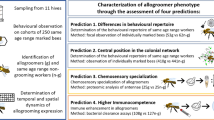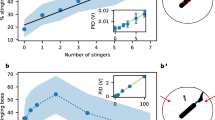Abstract
The functioning of a honeybee colony relies on the coordination of colony activities via inter-individual interactions. While the structure of this interaction network keeps the young individuals relatively isolated from the rest of the colony, there are two possible mechanisms that can generate this organizational immunity. A spatial segregation that restricts the young bees to the center of the colony can shield them with equal effectiveness as a behavioral segregation in which old bees choose to interact with young bees less frequently. We test the role of these two mechanisms by determining the interaction frequency between different age groups and testing their correlation with the olfactory sensitivity of different age groups to the cuticular odor of each other. Young bees were found to interact with bees of all age groups with equal frequency, which correlates with their lack of olfactory bias for any specific age, while old bees interacted more with other old bees, which correlates with their higher olfactory sensitivity toward the cuticular odor of old bees. The distribution of olfactory responsiveness was found to be positively skewed for old bees, which provides a mechanistic basis for the heterogeneous connectivity of the interaction network observed in an earlier study. As old bees are more likely to be responsible for introducing a potential disease into the colony from the outside and spreading it via the interaction network, these results suggest that behavioral segregation, mediated by olfactory discrimination, plays an important role in generating the organizational immunity within the honeybee colony.





Similar content being viewed by others
References
Allan SA, Slessor KN, Winston ML, King GGS (1987) The influence of age and task specialization on the production and perception of honey bee pheromones. J Insect Physiol 33:917–922
Arathi HS, Burns I, Spivak M (2000) Ethology of hygienic behaviour in the honey bee Apis mellifera L. (Hymenoptera: Apidae): behavioural repertoire of hygienic bees. Ethology 106:365–379
Blomquist GJ, Chu AJ, Remaley S (1980) Biosynthesis of Wax in the honeybee, Apis Mellifera L. Insect Biochem 10:313–321
Brandstaetter AS, Endler A, Kleineidam CJ (2008) Nestmate recognition in ants is possible without tactile interaction. Naturwissenschaften 95:601–608
Breed MD (1998) Chemical cues in kin recognition: criteria for identification, experimental approaches, and the honey bee as an example. In: Vander Meer RK, Winston ML, Espelie KE, Breed MD (eds) Chemical communication in social insects. Westview Press, Boulder, pp 57–78
Brockmann A, Groh C, Fröhlich B (2003) Wax perception in honeybees: contact is not necessary. Naturwissenschaften 90:424–427
Camazine S (1993) The regulation of pollen foraging by honey bees: how foragers assess the colony’s need for pollen. Behav Ecol Sociobiol 32:265–272
Châline N, Sandoz J, Martin SJ, Ratnieks FLW, Jones GJ (2005) Learning and discrimination of individual cuticular hydrocarbons by honeybees (Apis mellifera). Chem Senses 30:327–335
Couvillon MJ, Robinson EJH, Atkinson B, Child L, Dent KR, Ratnieks FLW (2008) En garde: rapid shifts in honeybee, Apis mellifera, guarding behaviour are triggered by onslaught of conspecific intruders. Anim Behav 76:1653–1658
Feigenbaum C, Naug D (2010) The influence of social hunger on food distribution and its implications for disease transmission in a honeybee colony. Insectes Sociaux 57:217–222
Francis BR, Blanton WE, Littlefield JL, Nunamaker RA (1989) Hydrocarbons of the cuticle and hemolymph of the adult honey bee (Hymenoptera, Apidae). Ann Entomol Soc Am 82:486–494
Getz WM (1982) An analysis of learned kin recognition in hymenoptera. J Theor Biol 99:585–597
Gordon DM (1992) A parallel distributed model of the behaviour of ant colonies. J Theor Biol 156:293–307
Gramacho KP, Spivak M (2003) Differences in olfactory sensitivity and behavioral responses among honey bees bred for hygienic behavior. Behav Ecol Sociobiol 54:472–479
Greene MJ, Gordon DM (2003) Cuticular hydrocarbons inform task decisions. Nature 423:32
Greene MJ, Gordon DM (2007) Interaction rate informs harvester ant task decisions. Behav Ecol 18:451–455
Howard RW, Blomquist GJ (2005) Ecological, behavioral, and biochemical aspects of insect hydrocarbons. Annu Rev Entomol 50:371–393
Johnson BR (2008a) Within-nest temporal polyethism in the honey bee. Behav Ecol Sociobiol 62:777–784
Johnson BR (2008b) Global information sampling in the honey bee. Naturwissenschaften 95:523–530
Kather R, Drijfhout F, Martin S (2011) Task group differences in cuticular lipids in the honey bee Apis mellifera. J Chem Ecol 37:205–212
López-Riquelme GO, Malo EA, Cruz-López L, Fanjul-Moles ML (2006) Antennal olfactory sensitivity in response to task-related odours of three castes of the ant Atta mexicana (Hymenoptera: Formicidae). Physiol Entomol 31:353–360
Masson C, Arnold G (1984) Ontogeny, maturation and plasticity of the olfactory system in the worker bee. J Insect Physiol 30:7–14
Masterman R, Ross R, Mesce K, Spivak M (2001) Olfactory and behavioral response thresholds to odors of diseased blood differ between hygienic and non-hygienic honey bees (Apis Mellifera L.). J Comp Physiol A 187:441–452
Naug D (2008) Structure of the social network and its influence on transmission dynamics in a honeybee colony. Behav Ecol Sociobiol 62:1719–1725
Naug D, Camazine S (2002) The role of colony organization on pathogen transmission in social insects. J Theor Biol 215:427–439
Naug D, Smith B (2007) Experimentally induced change in infectious period affects transmission dynamics in a social group. Proc Biol Sci 274:61–65
Page RE Jr, Robinson GE (1991) The genetics of division-of-labor in honey-bee colonies. Adv Insect Physiol 23:117–169
Page RE Jr, Erber J, Fondrk MK (1998) The effect of genotype on response thresholds to sucrose and foraging behavior of honey bees (Apis mellifera L.). J Comp Physiol A 182:489–500
Pham-Delegue MH, Trouiller J, Caillaud CM, Roger B, Masson C (1993) Effect of queen pheromone on worker bees of different ages - behavioral and electrophysiological responses. Apidologie 24:267–281
Schmid-Hempel P (1998) Parasites in social insects. Princeton University Press, Princeton, NJ
Schulz DJ, Vermiglio MJ, Huang ZY, Robinson GE (2002) Effects of colony food shortage on social interactions in honey bee colonies. Insectes Sociaux 49:50–55
Seeley TD (1982) Adaptive significance of the age polyethism schedule in honeybee colonies. Behav Ecol Sociobiol 11:287–293
Seeley TD (1989) Social foraging in honey bees: how nectar foragers assess their colony nutritional status. Behav Ecol Sociobiol 24:181–199
Wagner D, Brown MJF, Broun P, Cuevas W, Moses LE, Chao DL, Gordon DM (1998) Task-related differences in the cuticular hydrocarbon compositions of harvester ants, Pogonomyrmex barbatus. J Chem Ecol 24:2021–2037
Wilson EO (1976) Behavioral discretization and the number of castes in an ant species. Behav Ecol Sociobiol 1:141–154
Withers GS, Fahrbach SE, Robinson GE (1993) Selective neuroanatomical plasticity and division-of-labor in the honeybee. Nature 364:238–240
Acknowledgments
We thank Kevin Daly for his help with the EAG assay, Michael Greene for assistance with odor extraction methods and gas chromatography, Amanda Stammer for assisting in data collection, and Paul Ode and two anonymous reviewers for constructive comments on a previous version of this manuscript. Lahoma Howard and Kira Terry helped with colony maintenance and marking bees. JS also thanks Chris Mayack for the helpful discussions. This study was made possible by a National Science Foundation CAREER award to DN who designed the study and wrote the paper with JS who collected the data and was primarily responsible for analyzing it.
Author information
Authors and Affiliations
Corresponding author
Additional information
Communicated by M. Beekman
Electronic supplementary material
Below is the link to the electronic supplementary material.
ESM 1
Relative percent composition (mean ± SD) of some of the major cuticular hydrocarbons found on young, middle-aged, and old bees. The values were derived from relative peak abundance area corresponding to the six most prevalent peaks. (DOC 31 kb)
Rights and permissions
About this article
Cite this article
Scholl, J., Naug, D. Olfactory discrimination of age-specific hydrocarbons generates behavioral segregation in a honeybee colony. Behav Ecol Sociobiol 65, 1967–1973 (2011). https://doi.org/10.1007/s00265-011-1206-2
Received:
Revised:
Accepted:
Published:
Issue Date:
DOI: https://doi.org/10.1007/s00265-011-1206-2




